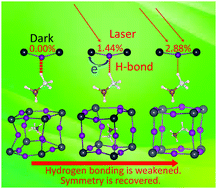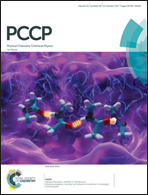Electronic excitation induced hydrogen-bond adjustment and lattice control in organic–inorganic hybrid cubic perovskites: a fixed occupation molecular dynamics study†
Abstract
The organic–inorganic hybrid perovskite has become a new type of semiconductor for low cost and highly efficient solar cells. However, the mechanism of interactions between the organic cation and the inorganic framework is still not completely clear under optical electronic excitation. In this work, we employ first-principles molecular dynamics with electronic excitation effects to prove that the hydrogen-bond interaction between the molecular cation and the inorganic lattice can be readily adjusted by several-percentage-valence-electron excitations in cubic CH3NH3PbI3. While the hydrogen-bond interaction causes serious lattice distortions, the electronic excitation can recover the lattice symmetry largely by weakening hydrogen bonding. The study offers atomic dynamics to understand the excitation process in the organic–inorganic hybrid perovskite semiconductor.



 Please wait while we load your content...
Please wait while we load your content...